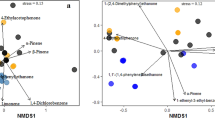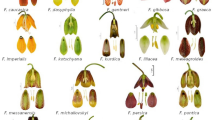Abstract
In this paper, we studied the floral biology of Tecoma fulva ssp. garrocha and T. stans in Vaqueros (Salta, Argentina), where both species coexist. We tested the idea that floral traits are associated with the pollinator types that visit them. According to our results, T. fulva ssp. garrocha presented traits common to bird flowers and were visited by two species of Trochilidae (Colibri serrirostris and Chlorostilbon lucidus). In addition, T. stans exhibited traits common to hymenoptera flowers and were visited principally by Apis mellifera and Bombus atratus. This study showed that floral traits are predictive of animal visitors.

Similar content being viewed by others
References
Aizen MA, Feinsinger P (1994) Forest fragmentation, pollination, and plant reproduction in a Chaco dry forest, Argentina. Ecology 75:330–351
Alcantara S, Lohmann LG (2010) Evolution of floral morphology and pollination system in Bignonieae (Bignoniaceae). Am J Bot 97:782–796
Bianchi AR (1996) Temperaturas medias estimadas para la región noroeste de Argentina. INTA, Salta, Argentina
Bianchi AR, Yañez CE (1992) Las precipitaciones en el noroeste argentino. INTA, Salta, Argentina
Castellanos MC, Wilson P, Thomson JD (2004) Anti-bee and pro-bird changes during the evolution of hummingbird pollination in Penstemon flowers. J Evol Biol 17:876–885
Dicks LV, Corbet SA, Pywell RF (2002) Compartmentalization in plant–insect flower visitor webs. J Anim Ecol 71:32–43
Eckhart V (1992) Spatio-temporal variation in abundance and variation in foraging behavior of the pollinators of gynodioecious Phacelia linearis (Hydrophyllaceae). Oikos 64:573–586
Faegri K, van der Pijl L (1971) The principles of pollination ecology. Pergamon, USA
Fenster CB, Armbruster WS, Wilson P, Dudash MR, Thomson JD (2004) Pollination syndromes and floral specialization. Ann Rev Ecol Evol Syst 35:375–403
Fenster CB, Cheely G, Dudash MR, Reynolds RJ (2006) Nectar reward and advertisement in hummingbird-pollinated Silene virginica (Cariophyllaceae). Am J Bot 93:1080–1087
Freitas BM, Paxton RJ (1998) A comparison of two pollinators: the introduced honey bee Apis mellifera and an indigenous bee Centris tarsata on cashew Anacardium occidentale in its native range of NE Brazil. J Appl Ecol 35:109–121
Gentry AH (1974) Coevolutionary patterns in Central American Bignoniaceae. Ann Mo Bot Gard 61:259–728
Goldblatt P, Nänni I, Berhardt P, Manning JC (2004) Floral biology of Hesperantha (Iridiaceae: Crocoideae): how minor shifts in floral presentation change the pollination system. Ann Mo Bot Gard 91:186–206
Gómez JM (2002) Generalización en la interacciones entre plantas y polinizadores. Rev Chil Hist Nat 75:105–116
Gómez JM, Zamora R (1999) Generalization vs. Specialization in the pollination system of Hormathophylla spinosa (Cruciferae). Ecology 80:796–805
Goulson D (2003) Effects of introduced bees on native ecosystems. Annu Rev Ecol Evol Syst 34:1–26
Gross CL, Mackay D (1998) Honeybees reduce fitness in the pioneer shrub Melastoma affine (Melastomataceae). Biol Conserv 86:169–178
Hegland SJ, Totland Ø (2005) Relationships between species’ floral traits and pollinator visitation in a temperate grassland. Oecology 145:586–594
Herrera J (1988) Pollination relationships in southern Spanish Mediterranean shrublands. J Ecol 76:274–287
Herrera CM (1996) Floral traits and plant adaptation to insect pollinators: a devil’s advocate approach. In: Lloyd DG, Barrett SCH (eds) Floral biology: studies on floral evolution in animal-pollinated plants, 1st edn. Chapman & Hall, New York, pp 140–190
Hingston AB, McQuillan PB (2000) Are pollination syndromes useful predictors of floral visitors in Tasmania? Austral Ecol 25:600–609
InfoStat (2009) InfoStat versión 2007. Grupo InfoStat. FCA, Universidad Nacional de Córdoba, Argentina
Irwin RE, Brody AK (1998) Nectar robbing in Ipomopsis aggregata: effects on pollinator behaviour and plant fitness. Oecology 116:519–527
Irwin RE, Brody AK, Waser NM (2001) The impact of floral larceny on individuals, populations, and communities. Oecology 129:161–168
Johnson SD, Linder PH, Steiner KE (1998) Phylogeny and radiation of pollination systems in Disa (Orchidaceae). Am J Bot 85:402–411
Lázaro A, Hegland S, Totland Ø (2008) The relationships between floral traits and specificity of pollination systems in three Scandinavian plant communities. Oecology 157:249–257
Mayfield MM, Waser NM, Price MV (2001) Exploring the most effective pollinator principle with complex flowers: bumblebees and Ipomopsis aggregata. Ann Bot 88:591–596
Narosky T, Izurieta D (2003) Guía para la identificación de las aves de Argentina y Uruguay. Vázquez-Mazzini, Argentina
Nicolson SW, Fleming PA (2003) Nectar as food for birds: the physiological consequences of drinking dilute sugar solutions. Plant Syst Evol 238:139–153
Ollerton J, Killick A, Lamborn E, Stella Watts, Whiston M (2007) Multiple meanings and modes: on the many ways to be a generalist flower. Taxon 56:717–720
Ollerton J, Alarcónn R, Waser NM, Price MV, Watts S, Cranmer L, Hingston A, Peter CI, Rotenberry J (2009) A global test of the pollination syndrome hypothesis. Ann Bot 103:1471–1480
Olmstead RG, Zjhra ML, Lohmann LG, Grose SO, Eckert AJ (2009) A molecular phylogeny and classification of Bignoniaceae. Am J Bot 96:1731–1743
Ortega-Baes P, Saravia M, Suhring S, Godínez-Alvarez H, Zamar M (2011) Reproductive biology of Echinopsis terschekii (Cactaceae): the role of nocturnal and diurnal pollinators. Plant Biol 13:33–40
Pérez P, Arroyo MTK, Medel R, Hershkovitz MA (2006) Ancestral reconstruction of flower morphology and pollination systems in Schizanthus (Solanaceae). Am J Bot 93:1029–1038
Price MV, Waser NM, Irwin RE, Campbell DR, Brody AK (2005) Temporal and spatial variation in pollination of a montane herb: a seven-year study. Ecology 86:2106–2116
Pyke GH, Waser NM (1981) The production of dilute nectar by hummingbird and honeyeater flowers. Biotropica 13:260–270
Stiles GF, Freeman CE (1993) Patterns in floral nectar characteristics of some bird-visited plant species from Costa Rica. Biotropica 25:191–205
Thomson JD, Wilson P, Valenzuela M (2000) Pollen presentation and pollination syndromes, with special reference to Penstemon. Plant Species Biol 15:11–29
Urcelay C, Morales CL, Chalcoff VR (2006) Relationship between corolla length and floral larceny in the South American hummingbird pollinated Campsidium valdivianum. Ann Bot Fenn 43:205–211
Waser NM, Chittka L, Price MV, Williams NM, Ollerton J (1996) Generalization in pollination systems, and why it matters. Ecology 77:1043–1060
Wilson P, Castellanos MC, Houge JN, Thomson JD, Armbruster SW (2004) A multivariate search for pollination syndromes among penstemons. Oikos 104:346–361
Wilson P, Castellanos MC, Wolfe AP, Thomson JD (2006) Shifts between bee and bird pollination in Penstemons. In: Waser NM, Ollerton J (eds) Plant-pollinator interactions: from specialization to generalization, 1st edn. The University of Chicago Press, Chicago, pp 47–69
Wood JRI (2008) A revision of Tecoma Juss (Bignoniaceae) in Bolivia. Bot J Linn Soc 156:143–172
Acknowledgments
The authors thank the handling editor and the anonymous reviewers for insightful comments that have improved this manuscript. We are grateful to Silvia Sühring for reviewing the manuscript and J. Arrueta for field and laboratories assistance. N. Frizza assisted with the English version of the paper. P.O.-B. thanks CIUNSalta for partial support.
Author information
Authors and Affiliations
Corresponding author
Rights and permissions
About this article
Cite this article
Curti, R.N., Ortega-Baes, P. Relationship between floral traits and floral visitors in two coexisting Tecoma species (Bignoniaceae). Plant Syst Evol 293, 207–211 (2011). https://doi.org/10.1007/s00606-011-0436-0
Received:
Accepted:
Published:
Issue Date:
DOI: https://doi.org/10.1007/s00606-011-0436-0




